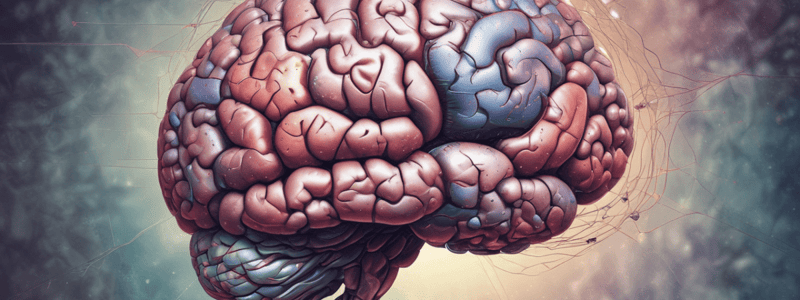Podcast
Questions and Answers
What is the typical location of Subependymal giant cell astrocytoma (SEGA)?
What is the typical location of Subependymal giant cell astrocytoma (SEGA)?
- Retina
- Third ventricle
- Subependymal tissue of the cerebral cortex
- Lateral ventricles adjacent to the foramen of Monro (correct)
What is a rare acute manifestation of Subependymal giant cell astrocytoma (SEGA)?
What is a rare acute manifestation of Subependymal giant cell astrocytoma (SEGA)?
- Growth of subependymal nodule(s) (SENs)
- Massive spontaneous haemorrhage (correct)
- Increased intracranial pressure
- Obstructive hydrocephalus
What is the ICD-O coding for Subependymal giant cell astrocytoma (SEGA)?
What is the ICD-O coding for Subependymal giant cell astrocytoma (SEGA)?
- XH1L48
- 2A00.0Y
- 9384/1 (correct)
- 15505165
What is the CNS WHO grade of Subependymal giant cell astrocytoma (SEGA)?
What is the CNS WHO grade of Subependymal giant cell astrocytoma (SEGA)?
What is the name of the editor responsible for Subependymal giant cell astrocytoma (SEGA)?
What is the name of the editor responsible for Subependymal giant cell astrocytoma (SEGA)?
What is the typical location of SEGAs on CT scans?
What is the typical location of SEGAs on CT scans?
What is the incidence rate of SEGA among patients with Tuberous Sclerosis?
What is the incidence rate of SEGA among patients with Tuberous Sclerosis?
What is the role of mTOR inhibitors in the treatment of SEGA?
What is the role of mTOR inhibitors in the treatment of SEGA?
What is the distinguishing feature between SEGA and SEN?
What is the distinguishing feature between SEGA and SEN?
What is the genetic profile of SEGAs?
What is the genetic profile of SEGAs?
What is the characteristic appearance of SEGAs in terms of their location?
What is the characteristic appearance of SEGAs in terms of their location?
What is the average Ki-67 proliferation index in SEGAs?
What is the average Ki-67 proliferation index in SEGAs?
What is the characteristic histopathological feature of SEGAs?
What is the characteristic histopathological feature of SEGAs?
What is the frequent immunohistochemical feature of SEGAs?
What is the frequent immunohistochemical feature of SEGAs?
What is the rare complication of SEGAs?
What is the rare complication of SEGAs?
What is the primary immunohistochemical feature that helps differentiate SEGA from its morphological mimics?
What is the primary immunohistochemical feature that helps differentiate SEGA from its morphological mimics?
What ultrastructural feature may be detectable in SEGA cells?
What ultrastructural feature may be detectable in SEGA cells?
In which situations may DNA methylome profiling be helpful in establishing the diagnosis of SEGA?
In which situations may DNA methylome profiling be helpful in establishing the diagnosis of SEGA?
What is associated with optimal outcome in patients with SEGA?
What is associated with optimal outcome in patients with SEGA?
What has been reported to result in significant reduction of tumour size and control of SEGA progression?
What has been reported to result in significant reduction of tumour size and control of SEGA progression?
Flashcards are hidden until you start studying
Study Notes
Subependymal Giant Cell Astrocytoma (SEGA)
Definition
- A periventricular tumor composed partly of large ganglion-like astrocytes, strongly associated with tuberous sclerosis (TS) (CNS WHO grade 1)
ICD-O and ICD-11 Coding
- ICD-O: 9384/1
- ICD-11: 2A00.0Y & XH1L48
Localization
- Typically arise from the subependymal tissue of the lateral ventricles adjacent to the foramen of Monro
- Rare locations include the third ventricle and the retina
Clinical Features
- Most patients present with signs and symptoms of increased intracranial pressure
- Tumor growth at the foramen of Monro can block cerebrospinal fluid circulation, leading to obstructive hydrocephalus
- Massive spontaneous hemorrhage may be an acute manifestation
- Growth of subependymal nodule(s) (SENs) into a SEGA is usually a gradual process
Imaging
- On CT, SEGAs appear as solid, partially calcified masses located in the walls of the lateral ventricles
- On MRI, the tumors are usually heterogeneous, isointense, or slightly hypointense on T1-weighted images, and hyperintense on T2-weighted images, with marked contrast enhancement
Epidemiology
- SEGA is the most common CNS neoplasm in patients with TS
- Incidence rate of SEGA among patients with TS is 5–15%
- Calculated overall incidence of SEGAs in the US Surveillance, Epidemiology, and End Results Program (SEER) 18 database is 0.027 cases per 100 000 person-years
Etiology
- SEGA has a strong association with inherited TS
- Evidence of biallelic inactivation of the TSC1 or TSC2 gene supports the hypothesis that SEGAs arise as a consequence of a second-hit mechanism
Pathogenesis
- Activation of the mTOR pathway has been shown in SEGAs, and clinical trials have shown reductions in tumor volumes using mTOR inhibitors
- Cell of origin: SEGAs demonstrate glial, neuronal, and mixed neuroglial features, suggesting a cell of origin with the capacity to undergo differentiation along glial, neuronal, and neuroendocrine lines
Studying That Suits You
Use AI to generate personalized quizzes and flashcards to suit your learning preferences.




